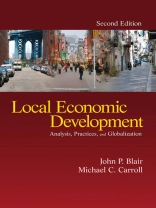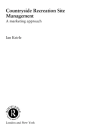Local economies are the building blocks for national ones. An updated and expansive core text, the Second Edition of Local Economic Development: Analysis, Practices, and Globalization provides a comprehensive introduction to the economics of local economic development. Delving into cutting-edge topics such as cluster analysis, creative class orientation, competitive advantage, social capital, business expansion and retention, and learning regions, this clearly written interdisciplinary text connects theories with real-life examples and offers the reader pragmatic tools for future application, including a valuable ‘how-to’ understanding regarding important qualitative tools and their interpretation.
Importantly, this text is uniquely accessible to students who lack a background in the field of economics.
New to this Edition
- Offers a global emphasis: Local economic development is clearly linked to national development throughout, making the text useful for adding an international component to traditional national economic development courses.
- Features an institutionalist focus: The text describes the ways political and the social environments interact with and influence the local development process, giving instructors opportunities to localize course material. It also addresses equity issues and the importance of interregional linkages, demonstrating the importance of an interdisciplinary approach.
- Demonstrates comparative versus competitive advantages: The author illustrates the changing perceptions of the sources of local advantages, given the dynamic global and technological environments.
- Provides valuable information on careers in the field: Students will learn about jobs where knowledge of local economic development is a primary or useful requirement, from opportunities as development officials in local agencies to banking to community development.
Intended Audience
This is an ideal core text for undergraduate and graduate students of economics, political science, geography, public administration, and urban and regional planning. It is also a valuable resource for economic development professionals, NGOs, County Commissioner offices and others involved in the economic aspects of local economic development.
Tabela de Conteúdo
Chapter 1. Local Economic Development in a Global Market
How Economists View the World
Models and Assumptions
Individual Behavior and Utility Maximization
Ideological Perspectives on Market Operations
How Markets Work
Supply and Demand
Supply, Demand, and Efficiency
Markets Are Not Always Efficient
The Role of Profits
Economic Development Defined
Careers in LED
The Nature of Regions
Types of Regions
Local, National, and Global Economic Development
Chapter 2. Business Location, Expansion, and Retention
Locational Factors
Inertia
Transportation Cost Minimizing Models
Production Costs
National Political Climate and Stability
Opportunity Creation
The Decision Making Process
Motivations
Practical Limitations on the Choice Process
Steps in the Corporate Site Selection Process
Changing Relative Importance of Locational Factors
Surveys of Location Factors
Survey Findings Past to Present
Conducting Business Retention and Expansion Programs
3. Markets, Urban Systems, and Local Development
Demand and Market Areas
Demand in a Spatial Setting
Competition for Markets
Threshold Demand and Range
Determinants of Market Size
The Urban Hierarchy and Urban System
Central Places
Goods and Services According to Urban Rank
Changing Urban Patterns
An Evaluation of the Central-Place Approach
Considerations Extraneous to Central-Place Theory
Transportation Costs
Market Overlap, Rate Absorption, and Price Discrimination
Product Differentiation
Agglomeration Economies
Institutional Factors
Non-employment Residential Locations and Commuting
Empirical Evidence
Globalization and Urban (City) Systems
How to Measure Areas of Influence
Survey Techniques
Reilly’s Law of Retail Gravitation
Probabilistic Models
Retail Spending
An Example
Hinterland Expansion Strategies
4. Economic Interdependence and Local Structure
Agglomeration Economies
Internal Agglomeration Economies
Direct Sales Purchases Linkages
Localization Economies
Urbanization Economies
Recap
Cluster Analysis
Measures of Economic Structure
North American Industrial Classification System (NAICS)
Location Quotients
Estimating Export Employment with Location Quotients
Surveys to Determine Export Activities
Coefficients of Specialization
Occupational Structure
Other Aspects of Regional Structure
5. Regional Growth and Development
Stages of Growth
Industrial Filtering (Life Cycle Model)
Adding New Work to Old
How Do Cities Move from One State to the Next?
Circular Flow Diagram
Elements of the Circular Flow Model
Equilibrium and Change
The Multiplier
The Export Base Theory of Growth
The Formal Income Model
How to Operationalize the Export Base Approach
Impact Studies and Export Base Forecasts
Critique of the Export-Base Approach
Primacy of Exports
Import Substitution
Productivity
Exports Not Always Exogenous
Small versus Large Regions
Feedbacks among Regions
Non-basic Activities May Not Increase
Long-Run Instability of the Multiplier
Excessive Aggregation
Supply-Side Approaches
Intermediate Inputs
Entrepreneurship
Capital
Land (Environmental Resources)
Labor
Supply and Demand Side Approaches: A Synthesis
6. Additional Tools for Regional Analysis
Shift and Share Analysis
An Application
Critique
Econometric and Simulation Models
Econometric Models
Caveats
Importance-Strength Analysis
Input-Output: Analysis
The Transactions Table
The Table of Direct Coefficients
The Table of Direct and Indirect Coefficients
Input-Output Applications
7. Institutionalist Perspectives on Local Development
External Benefits from Economic Development
Job and Income Creation
Fiscal Improvement
Physical Improvements
Who Benefits From Growth?
Characteristics of Resource Supply
Opponents of Growth
Subsidies, Competition and Economic Development
Is Local Economic Development a Zero Sum Game?
Inefficiency and Oversubsidization
Discretionary versus Entitlement Subsidies
Cost Minimization versus Human Capital Strategies
Social Capital and Economic Development
Generic Economic Problems and Social Capital
Ambiguous Reception of Social Capital
Social Capital and Local Development Strategies
Using Social Capital to Mitigate Economic Development Conflicts
Social Network Analysis: Getting the Right People to the Table
Targeting Development Efforts
Cluster-Based Economic Development
8. Local Economic Development in a Flattening World
Models of Trade and Resource Flows
Comparative Advantage
Resource Mobility
Economics of Migration
Retiree-Migrant Development Strategy
Mobility of Capital
Innovations and Ideas
Spatial Diffusion
Implications for Regional Development
Mobility and Development Policy
Jobs-to-People versus People-to-Jobs
Immigration and Urban Development
9. Land Use
What Gives Land Value?
Land Rents and Value
The Nature of Rent, Productivity and Access
Highest and Best Use
The Land Development Process
Developer Goals
The Market Study
Environmental Impact Statements
Profit Feasibility
The Development Decision
Implications of Financial Analysis for LED
Land-Use Patterns
The Monocentric City Model
The Desity Gradient
Roads and Axial Development
Agglomeration and the Multiple-Nuclear City
Speculation
Changing Land Use Patterns
Evaluating Metropolitan Spread (Urban Sprawl)
Land Use and Economic Development Tools
Zoning and Its Critics
Flexibility and Land Use Regulations
The Eminent Domain Controversy
Rights to Land and Economic Development
10. Housing and Neighborhood Development
Fundamentals of Housing Economics
Hedonic Pricing
Uncertainty, Market Imperfections, and Competition
Residential Location and Neighborhood Change
The Filtering-Down Theory
The Trade-Off Model
The Cultural Agglomeration Model
The Tiebout Model
The Aggregate Economic Fallout Model
Initiating and Perpetuating the Change Process
Housing Policy Issues
Rent Control versus Market Forces
Income Support versus Housing Assistance
Supply versus Demand Side Assistance
Ghetto Dispersal versus Ghetto Improvement
Dwelling-Unit versus Neighborhood Development
Linkage Between Local Housing and Global Financial Markets
Retail and Commercial Neighborhoods
The Social Economy of Neighborhoods
Community Development Corporations
Cooperatives
Community Gardens
11. Poverty and Lagging Regions
The Nature of Poverty
Conceptual Approaches
Demographics of Poverty
Spatial Concentrations of Urban Poverty
Regional Linkages: The Spread and Backwash Effects
Empirical Studies of Spatial Linkages
Spatial Linkages and Theories of Spatial Poverty
Policy Issues
Strengthening Linkages
Improving Productivity
Addressing Wage Rigidities
Employment Guarantee Schemes in India
Income Support
12. Local Governance, Finance, and Regional Integration
Spatial Perspectives on Government Functions
Distribution and the Race to the Bottom
Local Allocation
Public Transportation – An Example
Size and Scope of Local Governments
Economies and Diseconomies of Scale
Decision-Making Costs
Improving Government Efficiency
Using Prices and Fees
Local Taxation and Economic Development
Accountability
Intergovernmental Competition
Intergovernmental Grants and Coordination
Rearranging Functions
Privatization
Market Based Reforms in Education
Fiscal Impact and Benefit-Cost Studies
Fiscal Impact Studies
Benefit-Cost Analysis
13. Local Economic Development Planning
The Future and Local Development
Concern with Values and Attitudes
Technological Change
Systems Orientation
Importance of Timing
Planning Perspectives on Development Policy
The Planning Process
Limits of Planning
Planning and Future Studies Tools
Delphi Forecasting
Games
Scenarios
Environmental Scanning
About the Author
Sobre o autor
Michael C. Carroll is the Director of the Center for Regional Development and Associate Professor of Economics at Bowling Green State University. Prior to joining BGSU, he served on the faculty at Muskingum College and West Virginia State University. Dr. Carroll’s business experience includes positions as corporate controller, operations manager, and president. His research interests focus on regional economic development and social economics. He is Editor-in-Chief of Regional Science Policy and Practice and Associate Editor of Economic Development Quarterly. His writings have appeared in a variety of academic journals including, the Journal of Economic Issues, Annals of Regional Science, and the Industrial Geographer. Dr. Carroll also authored A Future of Capitalism: The Economic Vision of Robert Heilbroner (Macmillan and St. Martin’s Press) 1998. He earned his Ph.D. from Colorado State University.












